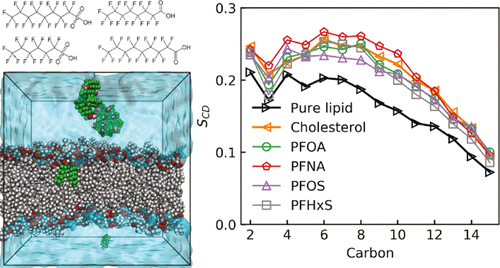当前位置:
X-MOL 学术
›
J. Phys. Chem. B
›
论文详情
Our official English website, www.x-mol.net, welcomes your
feedback! (Note: you will need to create a separate account there.)
Cholesterol-like Condensing Effect of Perfluoroalkyl Substances on a Phospholipid Bilayer.
The Journal of Physical Chemistry B ( IF 2.8 ) Pub Date : 2020-06-09 , DOI: 10.1021/acs.jpcb.0c00980 Zhiqiang Shen 1 , Jeffrey Ge 2 , Huilin Ye 1 , Shan Tang 3 , Ying Li 4
The Journal of Physical Chemistry B ( IF 2.8 ) Pub Date : 2020-06-09 , DOI: 10.1021/acs.jpcb.0c00980 Zhiqiang Shen 1 , Jeffrey Ge 2 , Huilin Ye 1 , Shan Tang 3 , Ying Li 4
Affiliation

|
To understand the potential cytotoxicity of perfluoroalkyl substances (PFAS), we study their interactions with a model phospholipid bilayer membrane using molecular dynamics (MD) simulations. Four typical PFAS molecules are investigated, including perfluorooctanoic acid (PFOA), perfluorononanoic acid (PFNA), perfluorooctanesulfonic acid (PFOS), and perfluorohexane sulfonate (PFHxS). All of these PFAS molecules are found to spontaneously penetrate the lipid bilayer within a short simulation time (a few nanoseconds). During the penetration process, further free-energy analysis reveals that a PFAS molecule encounters an energy barrier at the bilayer/water interface. To overcome this free-energy barrier, the PFAS molecule flips itself at the interface. We further investigate the influence of embedded PFAS molecules on the membrane properties. All of the embedded PFAS molecules are found to produce a cholesterol-like condensing effect on the lipid bilayer, which includes increases of the order parameters of lipid tails and the thickness of the lipid bilayer and a decrease of area per lipid. Moreover, the PFAS molecules are found to form hydrogen bonds with oxygen atoms at three different positions of a lipid molecule. Our work reveals the penetration pathway of PFAS molecules entering into a lipid bilayer. In addition, the cholesterol-like condensing effect induced by embedded PFAS molecules on model membranes is systematically investigated and discussed. Our simulations can help understand the physical mechanisms of PFAS cytotoxicity.
中文翻译:

全氟烷基物质对磷脂双层的类胆固醇缩合作用。
为了了解全氟烷基物质(PFAS)的潜在细胞毒性,我们使用分子动力学(MD)模拟研究了它们与模型磷脂双层膜的相互作用。研究了四种典型的PFAS分子,包括全氟辛酸(PFOA),全氟壬酸(PFNA),全氟辛烷磺酸(PFOS)和全氟己烷磺酸盐(PFHxS)。发现所有这些PFAS分子在较短的模拟时间内(几纳秒)即可自发渗透脂质双层。在渗透过程中,进一步的自由能分析表明,PFAS分子在双层/水界面遇到能量垒。为了克服这种自由能壁垒,PFAS分子在界面处翻转。我们进一步研究了嵌入式PFAS分子对膜性能的影响。发现所有嵌入的PFAS分子均对脂质双层产生类胆固醇的缩合作用,包括增加脂质尾部的有序参数和脂质双层的厚度以及减少每个脂质的面积。此外,发现PFAS分子在脂质分子的三个不同位置与氧原子形成氢键。我们的工作揭示了PFAS分子进入脂质双层的渗透途径。此外,系统地研究和讨论了嵌入式PFAS分子在模型膜上诱导的类胆固醇缩合作用。我们的模拟可以帮助理解PFAS细胞毒性的物理机制。其中包括增加脂质尾部的有序参数和脂质双层的厚度以及减少每个脂质的面积。此外,发现PFAS分子在脂质分子的三个不同位置与氧原子形成氢键。我们的工作揭示了PFAS分子进入脂质双层的渗透途径。此外,系统地研究和讨论了嵌入式PFAS分子在模型膜上诱导的类胆固醇缩合作用。我们的模拟可以帮助理解PFAS细胞毒性的物理机制。其中包括增加脂质尾部的有序参数和脂质双层的厚度以及减少每个脂质的面积。此外,发现PFAS分子在脂质分子的三个不同位置与氧原子形成氢键。我们的工作揭示了PFAS分子进入脂质双层的渗透途径。此外,系统地研究和讨论了嵌入式PFAS分子在模型膜上诱导的类胆固醇缩合作用。我们的模拟可以帮助理解PFAS细胞毒性的物理机制。我们的工作揭示了PFAS分子进入脂质双层的渗透途径。此外,系统地研究和讨论了嵌入式PFAS分子在模型膜上诱导的类胆固醇缩合作用。我们的模拟可以帮助理解PFAS细胞毒性的物理机制。我们的工作揭示了PFAS分子进入脂质双层的渗透途径。此外,系统地研究和讨论了嵌入式PFAS分子在模型膜上诱导的类胆固醇缩合作用。我们的模拟可以帮助理解PFAS细胞毒性的物理机制。
更新日期:2020-07-02
中文翻译:

全氟烷基物质对磷脂双层的类胆固醇缩合作用。
为了了解全氟烷基物质(PFAS)的潜在细胞毒性,我们使用分子动力学(MD)模拟研究了它们与模型磷脂双层膜的相互作用。研究了四种典型的PFAS分子,包括全氟辛酸(PFOA),全氟壬酸(PFNA),全氟辛烷磺酸(PFOS)和全氟己烷磺酸盐(PFHxS)。发现所有这些PFAS分子在较短的模拟时间内(几纳秒)即可自发渗透脂质双层。在渗透过程中,进一步的自由能分析表明,PFAS分子在双层/水界面遇到能量垒。为了克服这种自由能壁垒,PFAS分子在界面处翻转。我们进一步研究了嵌入式PFAS分子对膜性能的影响。发现所有嵌入的PFAS分子均对脂质双层产生类胆固醇的缩合作用,包括增加脂质尾部的有序参数和脂质双层的厚度以及减少每个脂质的面积。此外,发现PFAS分子在脂质分子的三个不同位置与氧原子形成氢键。我们的工作揭示了PFAS分子进入脂质双层的渗透途径。此外,系统地研究和讨论了嵌入式PFAS分子在模型膜上诱导的类胆固醇缩合作用。我们的模拟可以帮助理解PFAS细胞毒性的物理机制。其中包括增加脂质尾部的有序参数和脂质双层的厚度以及减少每个脂质的面积。此外,发现PFAS分子在脂质分子的三个不同位置与氧原子形成氢键。我们的工作揭示了PFAS分子进入脂质双层的渗透途径。此外,系统地研究和讨论了嵌入式PFAS分子在模型膜上诱导的类胆固醇缩合作用。我们的模拟可以帮助理解PFAS细胞毒性的物理机制。其中包括增加脂质尾部的有序参数和脂质双层的厚度以及减少每个脂质的面积。此外,发现PFAS分子在脂质分子的三个不同位置与氧原子形成氢键。我们的工作揭示了PFAS分子进入脂质双层的渗透途径。此外,系统地研究和讨论了嵌入式PFAS分子在模型膜上诱导的类胆固醇缩合作用。我们的模拟可以帮助理解PFAS细胞毒性的物理机制。我们的工作揭示了PFAS分子进入脂质双层的渗透途径。此外,系统地研究和讨论了嵌入式PFAS分子在模型膜上诱导的类胆固醇缩合作用。我们的模拟可以帮助理解PFAS细胞毒性的物理机制。我们的工作揭示了PFAS分子进入脂质双层的渗透途径。此外,系统地研究和讨论了嵌入式PFAS分子在模型膜上诱导的类胆固醇缩合作用。我们的模拟可以帮助理解PFAS细胞毒性的物理机制。











































 京公网安备 11010802027423号
京公网安备 11010802027423号